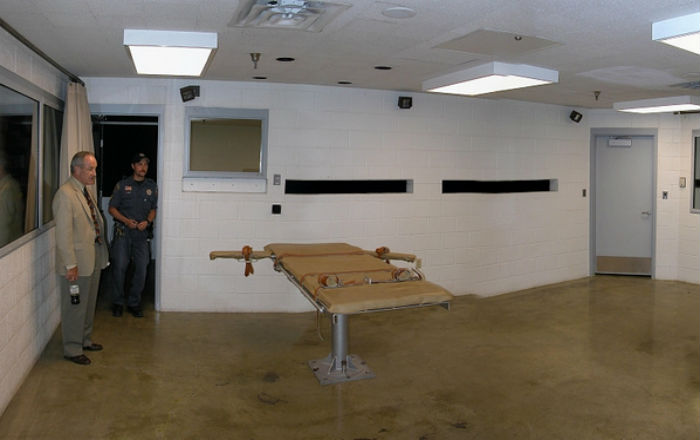
Written by Marcos Camargo
Supporters of capital punishment have had a bad year. On Jan. 16, 2014, Ohio death row inmate Dennis McGuire was strapped to table and injected with a lethal dose of midazolam (a benzodiazepine tranquilizer) and hydromorphone (a potent narcotic painkiller). Instead of losing complete consciousness, McGuire writhed and gasped for over twenty minutes before finally expiring. Witnesses to the execution later said that it “looked and sounded as though he [McGuire] was suffocating.”
This particular drug cocktail was a new form of lethal injection. Ohio, among other states, has been faced with supply shortages of the chemicals typically used to perform executions. So McGuire became a guinea pig—a test subject in an experiment to find new “humane” ways to kill. By the end of 2014, two more executions were botched— both ended in prolonged agony for the inmates, and both employed experimental chemical combinations because of drug shortages.
These shortages come as a result of refusals by European pharmaceutical manufacturers to sell their products to U.S. prisons intent on using the drugs for execution. Nearly every country in Europe has abolished the death penalty, and many Europeans want to see the U.S. follow their lead. However, thirty-nine states and the federal government still have capital punishment on the books. Most of these states have made lethal injection the only legal form of execution.
In large part, abolishing other execution procedures came as an appeasement to those who argue that the death penalty constitutes “cruel and unusual punishment.” Death penalty supporters claim that lethal injection can’t possibly be cruel and unusual since the prisoner simply falls into a deep sleep, never again to wake up. But the past year has proven otherwise. This recent string of bungled executions has lawmakers scrambling to find new ways to humanely kill condemned inmates.
This has led some states to consider reinstating previously abandoned methods—including the particularly gruesome use of firing squads—as a means of carrying out the business of death. On Feb. 4, 2015, Utah State Representative Paul Ray (R-Clearfield) introduced House Bill 11 (H.B. 11), which would amend the Utah Code of Criminal Procedure to allow the use of firing squads in the event that Utah ever runs out of its most effective thanatotic chemicals. Ray touts the firing squad as “a lot more humane than the electric-chair, hanging, or lethal injection,” while at the same time admonishing his fellow lawmakers not to get “caught up” in ensuring the painless demise of convicted murderers.
“These people are being put to death for a reason… their victims didn’t get to die in a less excruciating manner,” Ray said in his arguments to the House Law Enforcement and Criminal Justice Committee on Wednesday.
Ray was quick to remind committee members “this is not a debate on the death penalty.” But he also claimed to “understand the people who are opposed to the death penalty,” and conceded that abolishing capital punishment in Utah is “a discussion we probably ought to have at some point in time.”
So my question is this: why not have that discussion now? What better time for Utahns to reevaluate the priorities and motivations behind taking the lives of their fellow citizens?
Don’t get me wrong, I think most death row inmates are violent offenders who need to be separated from society. But when examined closely, the most popular arguments in favor of capital punishment don’t hold up to scrutiny. The most oft cited reasons given for continued executions include recidivism (the idea that the only way to ensure killers don’t kill again is to snuff them out), deterrence (the belief that exterminating murderers sends a message to other would-be killers), and—my favorite of all—cost (the notion that eliminating violent offenders saves the money it would take to imprison them for life). The interesting thing about the cost argument is the fact that the exact opposite is true.
The money it takes to carry out a single death sentence far outweighs the expense of locking up a person for life.
Gary Syphus of the Legislative Fiscal Analyst’s Office reported that Utah spends $1.6 million more per inmate to carry out an execution than it does to sentence the same prisoner to life without parole. Since 1976 (the year the U.S. Supreme Court lifted a four year moratorium on capital punishment), Utah has put to death seven men. Using Syphus’ numbers this means $11.2 million dollars have been spent to kill seven people who would otherwise have been rotting in a prison cell unable to inflict further violence. So why does our society spend millions of extra dollars to execute certain criminals (many of whom live for decades on death row as they pursue multiple appeals), rather than just permanently locking these people away?
The answer comes in one word—revenge. When capital punishment is boiled down to its most concentrated form, all that remains is vengeance. It’s the mentality of an eye for an eye, a life for a life—the law of retaliation. And who knows, maybe we humans still need some outlet to unleash our most primal instincts, and maybe capital punishment serves that purpose. But that’s a question for a psychologist.
I, however, would like to offer an alternative, just a slight realignment of our vengeful urges. Rather than spend millions to eliminate a few of society’s biggest creeps, we should instead take all that money and direct it toward solving the hundreds of cold-case murders in Utah. A 2008 report released by Scripps Howard News Service lists Utah as having 424 unsolved murders since 1980. That’s 424 families that live under the constant cloud of not knowing who killed their loved one. If we took the $11.2 million spent on exacting revenge against seven men, and instead put that money toward solving those 424 murder cases, each investigation would receive over $25,000 in additional funding. Just think how many families would receive closure. But here we are, debating if we should poison, shoot, or electrocute our way to “justice,” while over 400 other murderers run free.
Related stories: DEVIL’S ADVOCATE: Death by firing squad is the better of two evils
UPDATE: According to a Salt Lake Tribune article published just four hours after this opinion, the Utah House of Representative passed HB11 reinstating the firing squad as a secondary method of execution. The bill passed 39-34 with a minimum of 38 votes required for passage. The bill will now go to the Utah Senate.
 Marcos grew up in the rural heartland of Oregon. In 2003 he moved to Utah to find his place in the world and fell in love with the deserts of America’s arid country. An avid student of history and politics, he has a great interest in Western and Native American history and culture. He spends his free time exploring the wilderness of the Southwest.
Marcos grew up in the rural heartland of Oregon. In 2003 he moved to Utah to find his place in the world and fell in love with the deserts of America’s arid country. An avid student of history and politics, he has a great interest in Western and Native American history and culture. He spends his free time exploring the wilderness of the Southwest.



